Intermarkets' Privacy Policy
Donate to Ace of Spades HQ!
aceofspadeshq at gee mail.com
Buck:
buck.throckmorton at protonmail.com
CBD:
cbd at cutjibnewsletter.com
joe mannix:
mannix2024 at proton.me
MisHum:
petmorons at gee mail.com
J.J. Sefton:
sefton at cutjibnewsletter.com
Wednesday Overnight Open Thread - January 7, 2026 [Apollo Rex]
Corporate Pranks Cafe
Governor Ron DeSantis Announces Special Session to Redistrict Florida
Tim Walz Activates National Guard -- Hinting He'll Use It to Fight FEDERAL LAW ENFORCEMENT
Two Venezuela-Linked "Dark Fleet" Ships Change Their Registrations Mid-Cruise to Russian In the Belief That This Will Protect Them from Trump;
But Trump Gives No Effs and Seizes Them
RFKJr. Unveils What Leftwing Ninnies Are Calling an "Upside-Down" Food Pyramid
House Oversight Committee Takes Testimony About Somali Fraud (While Democrats Yammer about January 6th and White Supremacy)
Minnesota Terrorist Tries to Ram ICE with Her Car, Gets Fatally Shot in Self-Defense
Update: Slowed Video Shows Car Hitting Agents
"Biden" Signed an Executive Order Relieving "Day Cares" of the Need to Provide Verification of Their "Enrollees"
A Trans "Woman" Beats His Pud In the Planet Fitness Woman's Bathroom; Planet Fitness Throws Out The Actual Woman Who Reported the Public Masturbator, Let the Public Masturbator Stay
Jim Sunk New Dawn 2025
Jewells45 2025
Bandersnatch 2024
GnuBreed 2024
Captain Hate 2023
moon_over_vermont 2023
westminsterdogshow 2023
Ann Wilson(Empire1) 2022
Dave In Texas 2022
Jesse in D.C. 2022
OregonMuse 2022
redc1c4 2021
Tami 2021
Chavez the Hugo 2020
Ibguy 2020
Rickl 2019
Joffen 2014
maildrop62 at proton dot me
TBD
Winter Sky Wonders For Your Christmas Telescope
Greetings everyone! It has been a long time since I've posted the astronomy thread, but I wasn't going to let Christmas come and go without a quick guide for you amateurs just getting your first telescope this week.
I've kept the targets simple and spectacular. For those of you still thinking about getting a scope, you're in luck: I review the upsides and downsides of three great scopes ranging from just $99 to $380 you still have time to grab before Thursday.
Let's dive in!
So, you've unpacked your scope, read the instruction manual, collimated your optics/adjusted your mount, and are about to head outside. Here are the targets I suggest you aim for to start your hobby with a bang. Note: all images that appear in the target section are sketches. Photographs are far more sensitive than the human eye and can give a false sense of what is-and what isn't- visible.

The Andromeda Galaxy is the largest in our Local Group, at over twice the mass and nearly twice as large as our own Milky Way. It's apparent magnitude is around 3.5, bright enough to eye directly or with averted vision in all but the most light polluted skies:
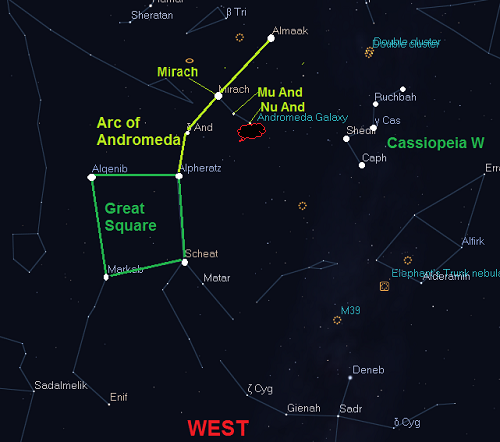
While easier to catch in the Fall when overhead because Pegasus and Andromeda dominate your overhead view, it's still plainly visible if you orient yourself properly and keep the W and Andromeda Arc in mind. As the Summer Triangle sets towards the West, the Great Square follows suit but not for a few hours after sunset.
Covering an area many times the size of the full moon, the galactic core is the bright patch we can eye, with the outer arms and dust revealing itself through binoculars and telescopes.
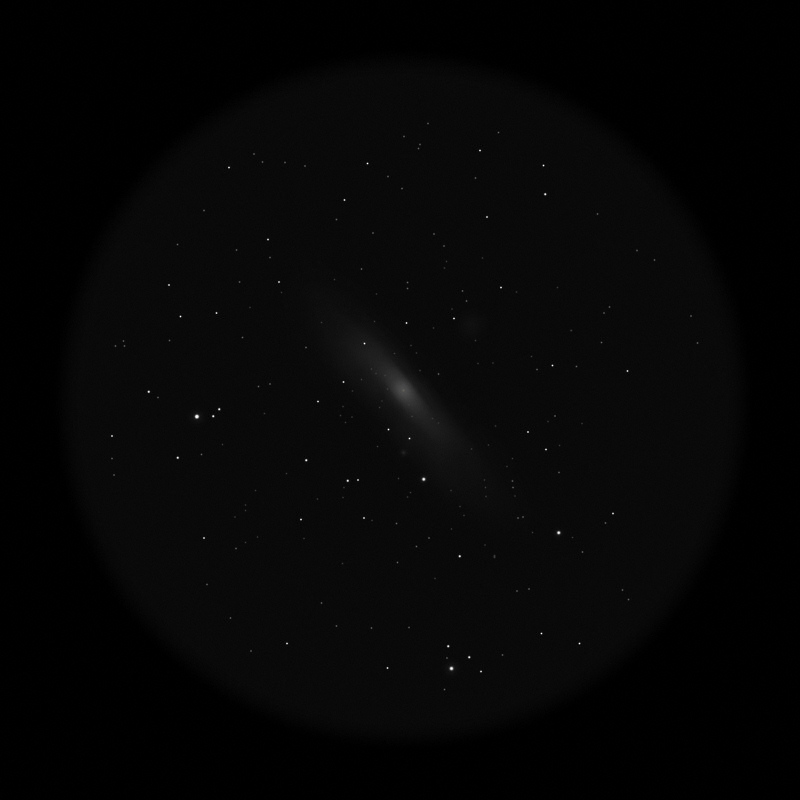
French amateur De Laet created this wonderful sketch and posted some detailed observational notes on his ETX site. While the galaxy appears smaller and fuzzier through his binoculars, the view still wowed him. Pay attention to several of his suggestions for pulling out detail:
In general, binoculars are not the preferred instrument to study galaxies. But what an amazing view has the Andromeda Galaxy to offer in a pair of binoculars! The large central bulge of M31 can be seen with direct vision. The nucleus appears star like. The elongated halo fades slowly away in the background. With averted vision, the halo can be followed for 1 ˝° on each side of the central bulge. While nucleus, central bulge and halo are visible as distinct features, they happen to be merged together as one solid body. The NW side of the galaxy is tilted towards us. Here is where multiple dust lanes absorb the soft glowing light of the galaxy in our line of sight. That is why the NW side of the galaxy appears ‘bordered’, while the SE side shows a softer edge. I did have the impression that another dust lane could be seen on the SE side of the galaxy, or just behind the central bulge. If the dust lanes don’t look obvious to you at first, try to gently rock the binoculars. The motion will stimulate your night vision. As if the Andromeda Galaxy isn’t interesting enough to observe, there is more to go after: satellite galaxies! One of M31’s satellites is M32. It can be found just S of the central bulge. It appears like a small star that is put out of focus. The other satellite galaxy, M110, can be found at ˝° NW of the central bulge. M110 looks like a faint isolated cloud when seen with averted vision.
Through a modest telescope, the satellites and dust lanes come into better focus than with binoculars; with a scope of at least 4" aperture, starfield NGC 206 becomes visible; and if you are lucky enough to own a scope of at least 8" aperture, globular cluster G1 can be teased out about 2.5 degrees away. G1 is the brightest, largest globular known in the Local Group of galaxies, putting Omega Centauri to shame by several orders of magnitude. Below is a guide for the brightest features visible in most amateur scopes:
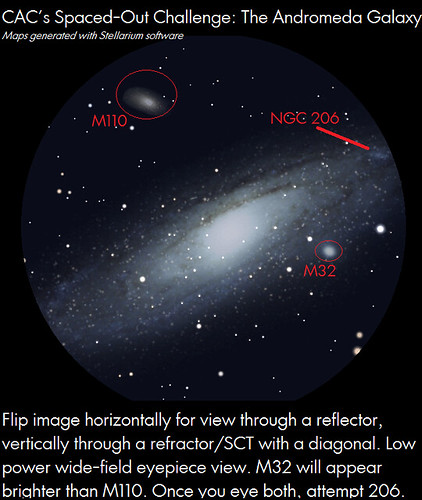
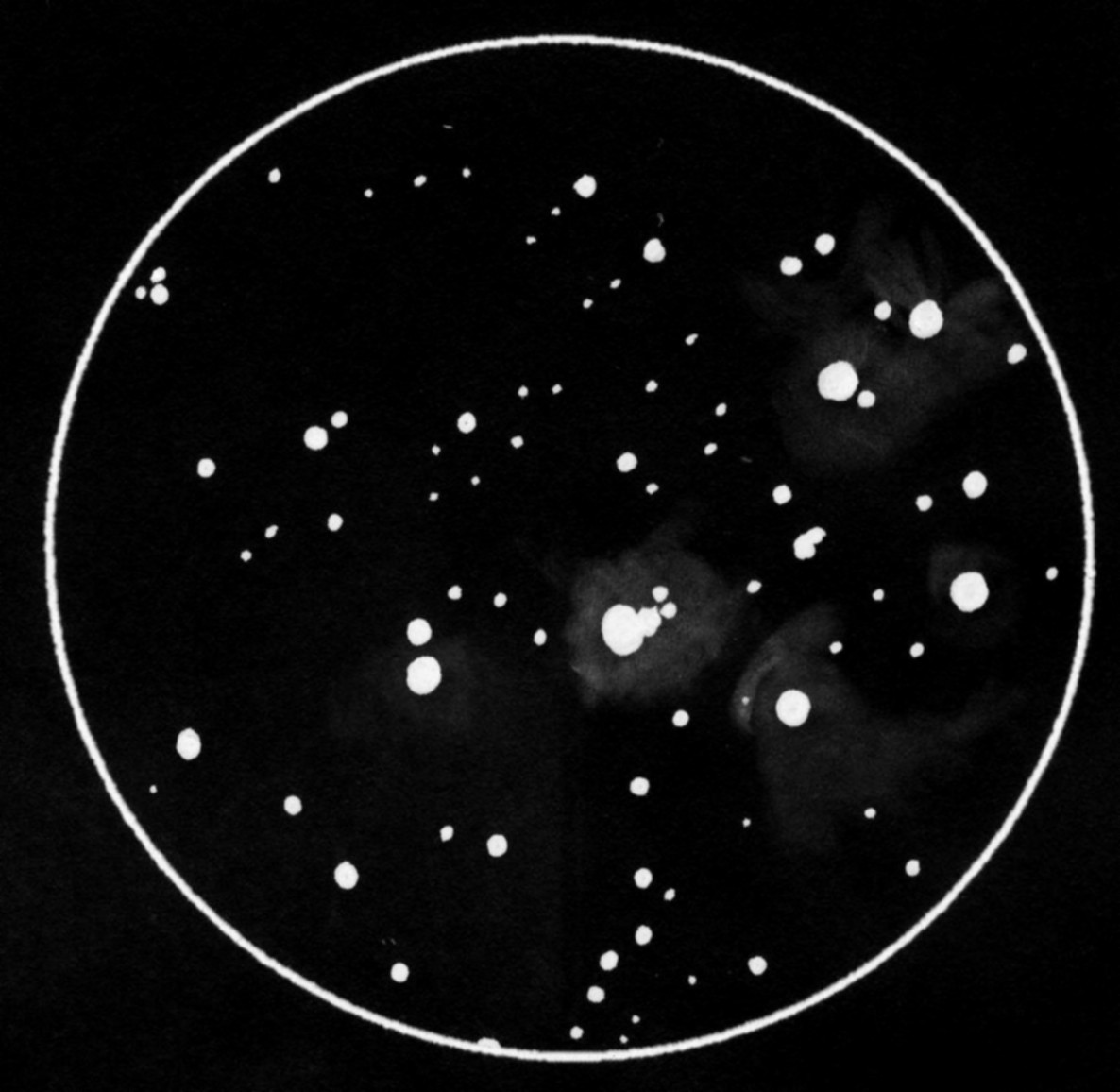
Arguably the most beautiful open cluster in the sky, the Pleiades is visible from all but the most light polluted spots on the planet (think Times Square or the Luxor in Vegas). The Seven Sisters are protected from lustful Orion by Taurus the Bull, his raging red eye (Aldebaran) glaring at the hunter:
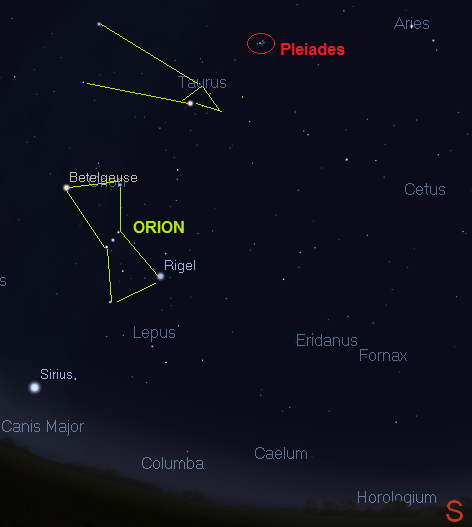
High overhead later in the evening, it is one of the few objects best seen in smaller telescopes or binoculars due to its large size.
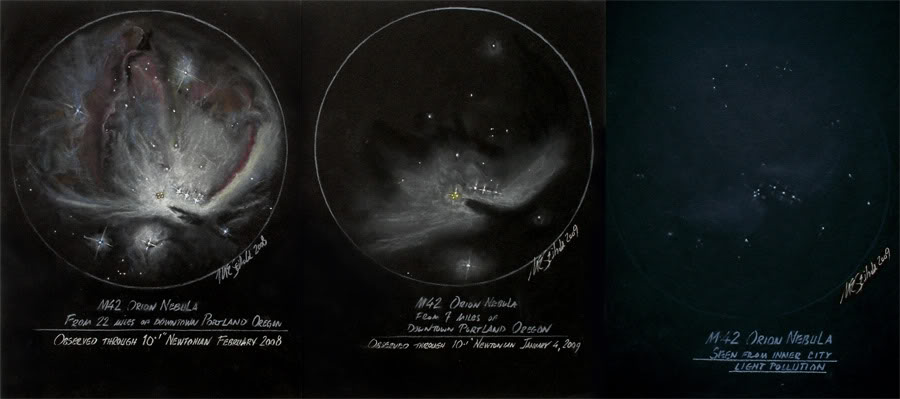
The Great Nebula in Orion has been photographed more than any other deep sky object, and it's not hard to see why: bright, expansive, and colorful, it has been observed for over four hundred years yet reveals surprises at a constant pace. The beautiful Trapezium stars, which illuminate much of the nebula, are found at it's heart. This quadruplet actually has two fainter members that can be picked out with larger telescopes, and was first documented by Galileo. At only 100,000 years old, these stars are some of the youngest objects we can spot in the sky. Theta 2 is a nearby double that also helps to illuminate the billowy cloud.
The nebula is impressive from even the worst sky, and leaves you at a loss of words from a dark one. Color is absolutely visible with adapted eyes from a dark site. I've noticed traces of purple, blue and green through my 8" XT8.
Astronomer Bob King has a fantastic write up over at Sky and Telescope documenting how you can perceive three-dimensional features in this distant object, and the always great David Fuller outlines pulling out color (including red!) using a flashlight. Do not be surprised if you find yourself lost in its billowy cloud- this is the highlight of the Winter sky.
Finding it doesn't even require a chart: the parent constellation is impossible to miss: a seven-star giant, two atop, three belt stars, and two below, with a dangling sword of three stars under the belt. The Great Nebula is the middle "star" in said sword.

Pulling things back to just a few hundred million miles away, the largest planet in our solar system rises late in the evening and outshines everything else until Venus peeps in before sunrise. Its four moons are clearly visible in even a small telescope, while it's Great Red Spot, when you can catch it, is always a fun hunt.
If you've read the astronomy threads and have kicked around the idea of getting a scope all year long, you still have time to make an impulse buy you won't regret. The buyer's guide from 2013 is linked at the bottom of this thread outlining accessories. Oh and those night vision-preserving goggles from the light pollution thread? Orion is selling them right now for only $1.99, and you can buy them through ">Ace's Amazon Store. That all out of the way, onto the scopes.
The $99 Option: VIXEN OPTICS SPACE EYE 70 - 70mm refractor

from Adorama
Hands down, the best telescope you can get for under a hundred bucks. Light weight, great optics for the price, and not-half-bad eyepieces. You get what you pay for- the mount is wobbly with windy conditions, the finderscope is sub-par, and you should definitely upgrade on the eyepieces. But right out of the box, the Vixen gives surprisingly crisp views of Jupiter, Saturn's rings, lunar features, and brighter deep sky objects like the Pleiades. Adorama is the only company selling it for this cheap, and I don't know if it's just for Christmas or they are clearing them out. So if you're cheap but still waiting, why?
The $200 Option: the "Costco" Celestron: C102GT Nexstar Refractor
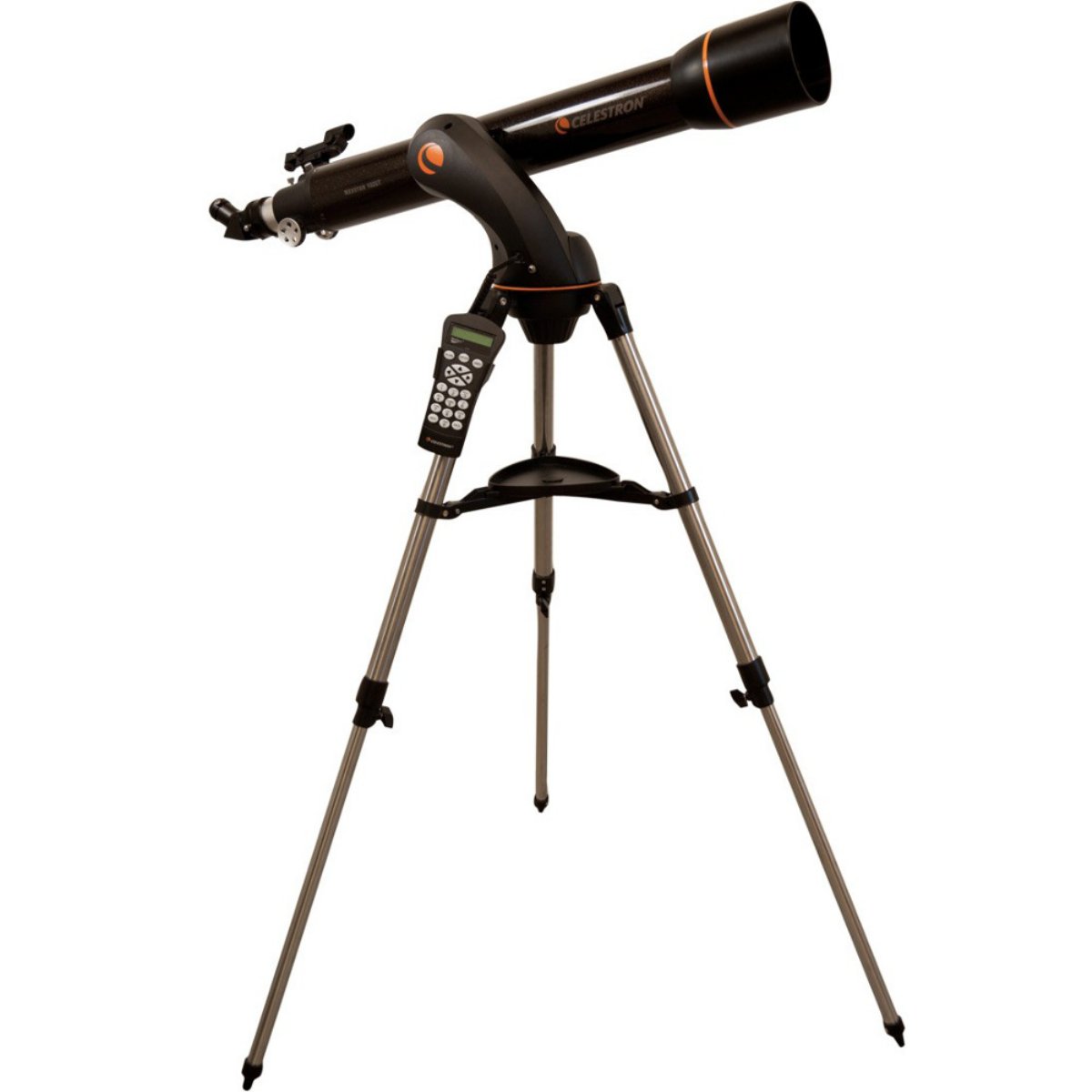
The C102GT may seem familiar to readers of the Spaced Out Challenge, and that's because the optical tube itself was being sold for $60 by OPT a little over a year ago. The Go-To mount is decent for a beginner, a with a bit of give that makes high power viewing slightly frustrating. But the package comes with five eyepieces, three of which aren't half-bad, not to mention a computerized mount, very good optics for the price of the tube (rivaling many that sell for hundreds more). B&H is currently the only vendor selling this new, and at the $200 price (shipped!) If you have a bit more scratch lying around and want a better view of deep sky targets and double stars than what the Vixen can provide, here's your scope.
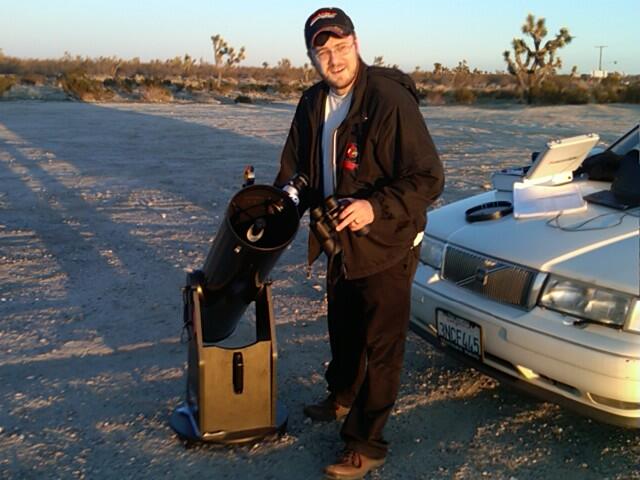
$380 shipped.
The best introductory amateur telescope sold in the last hundred years, period. Tough. Large. Extremely easy to assemble and use. Highly adaptable. Intimidating to your neighbors. Make that guy in building D with his spotting scope feel small and inadequate.

The upsides? Too many to count: incredible views for the price, just $380. I've glimpsed the Pillars of Creation, Saturn's fainter rings, too many galaxies and planetary nebulae to count, all for $380. The telescope offers incredibly great optics for just $380. Did I mention it is only $380? The customer service and warranty from Orion are just cherries on top. For residents of suburban and urban areas, it cuts through some of the worst light pollution and delivers. Take it out to a dark sky site with decent eyepieces and it will change you.
The downsides? Like all reflectors, it will require occasional collimation (aligning of the mirrors). It is the largest of all the scopes discussed, weighing in at 40lbs assembled, breaking down into two 20 pound pieces (the optical tube and mount). Deep sky astrophotography requires serious DIY motorization. Tracking objects is all on you. The red-dot finder should be upgraded. It takes up about 48x24x24 in your closet. But it's also only $380. Of the three telescopes, if the weight and occasional adjustments don't scare you, you are insane to pass over it. Here's how I imagine the conversation goes in your house if you do:
Extremely excited 10-year-old-child-of-reader: OMG did you get the big telescope daddy/mommy?
You: no
Devastated child who will hate you forever: WHY?
You: because I'm a terrible person.
My wife calls it the other woman, and for good reason. If it were possible to love an inanimate object, well, here you go.
Orion recently released an upgraded version, the SkyQuest XT8 PLUS, with better collimation knobs, an adjustable altitude clutch, better included eyepieces, an eyepiece rack, a shorty barlow lens, solar filter, and a striking finish:
At $500 shipped, it's up to you whether that seductive blue is worth the extra coin. I'd stick with the original black beauty myself.
The full Beginner's Buyer's Guide, our Comet Guide (featuring additional grab-and-go telescopes), and any other edition you're looking for can be found in the master index of all Spaced-Out Challenge threads here, but of course you can always inquire about binoculars, telescopes, and all the rest in the comments. As always, if you have astrophotography, product recommendations, or astronomy news you'd like to see on a future Spaced-Out Challenge, email me at theoneandonlyfinn (at) gmail.com, or tweet me @conartcritic.
With all of that said, clear skies to you, and keep looking up!
Skip : "G'Day everyone ..."
Biden's Dog sniffs a whole lotta malarkey, : "BOING! ..."
Skip : "Good, another reason for rage the Leftists needed. ..."
Publius Redux: "455 When in the US my home is in Spring, Texas" ..."
man: "When in the US my home is in Spring, Texas" Hey ..."
tcn in AK: "I am deeply and profoundly grateful to God for the ..."
TJ jackson: "I'm not sure who the biggest fools are. Walz, Cr ..."
Rev. Wishbone : "WTH? LauraW comes in here, drops a couple of stin ..."
tcn in AK: "I saw him on the front side of the vehicle and he ..."
Biden's Dog sniffs a whole lotta malarkey, : "Yay! But... I'll be happy when we have an "old Ve ..."
Biden's Dog sniffs a whole lotta malarkey, : "The [s]Shah[/s] [b]CIA[/b] again turned it down. ..."
Wednesday Overnight Open Thread - January 7, 2026 [Apollo Rex]
Corporate Pranks Cafe
Governor Ron DeSantis Announces Special Session to Redistrict Florida
Tim Walz Activates National Guard -- Hinting He'll Use It to Fight FEDERAL LAW ENFORCEMENT
Two Venezuela-Linked "Dark Fleet" Ships Change Their Registrations Mid-Cruise to Russian In the Belief That This Will Protect Them from Trump;
But Trump Gives No Effs and Seizes Them
RFKJr. Unveils What Leftwing Ninnies Are Calling an "Upside-Down" Food Pyramid
House Oversight Committee Takes Testimony About Somali Fraud (While Democrats Yammer about January 6th and White Supremacy)
Minnesota Terrorist Tries to Ram ICE with Her Car, Gets Fatally Shot in Self-Defense
Update: Slowed Video Shows Car Hitting Agents
"Biden" Signed an Executive Order Relieving "Day Cares" of the Need to Provide Verification of Their "Enrollees"
A Trans "Woman" Beats His Pud In the Planet Fitness Woman's Bathroom; Planet Fitness Throws Out The Actual Woman Who Reported the Public Masturbator, Let the Public Masturbator Stay
Paul Anka Haiku Contest Announcement
Integrity SAT's: Entrance Exam for Paul Anka's Band
AllahPundit's Paul Anka 45's Collection
AnkaPundit: Paul Anka Takes Over the Site for a Weekend (Continues through to Monday's postings)
George Bush Slices Don Rumsfeld Like an F*ckin' Hammer
Democratic Forays into Erotica
New Shows On Gore's DNC/MTV Network
Nicknames for Potatoes, By People Who Really Hate Potatoes
Star Wars Euphemisms for Self-Abuse
Signs You're at an Iraqi "Wedding Party"
Signs Your Clown Has Gone Bad
Signs That You, Geroge Michael, Should Probably Just Give It Up
Signs of Hip-Hop Influence on John Kerry
NYT Headlines Spinning Bush's Jobs Boom
Things People Are More Likely to Say Than "Did You Hear What Al Franken Said Yesterday?"
Signs that Paul Krugman Has Lost His Frickin' Mind
All-Time Best NBA Players, According to Senator Robert Byrd
Other Bad Things About the Jews, According to the Koran
Signs That David Letterman Just Doesn't Care Anymore
Examples of Bob Kerrey's Insufferable Racial Jackassery
Signs Andy Rooney Is Going Senile
Other Judgments Dick Clarke Made About Condi Rice Based on Her Appearance
Collective Names for Groups of People
John Kerry's Other Vietnam Super-Pets
Cool Things About the XM8 Assault Rifle
Media-Approved Facts About the Democrat Spy
Changes to Make Christianity More "Inclusive"
Secret John Kerry Senatorial Accomplishments
John Edwards Campaign Excuses
John Kerry Pick-Up Lines
Changes Liberal Senator George Michell Will Make at Disney
Torments in Dog-Hell
The Ace of Spades HQ Sex-for-Money Skankathon
A D&D Guide to the Democratic Candidates
Margaret Cho: Just Not Funny
More Margaret Cho Abuse
Margaret Cho: Still Not Funny
Iraqi Prisoner Claims He Was Raped... By Woman
Wonkette Announces "Morning Zoo" Format
John Kerry's "Plan" Causes Surrender of Moqtada al-Sadr's Militia
World Muslim Leaders Apologize for Nick Berg's Beheading
Michael Moore Goes on Lunchtime Manhattan Death-Spree
Milestone: Oliver Willis Posts 400th "Fake News Article" Referencing Britney Spears
Liberal Economists Rue a "New Decade of Greed"
Artificial Insouciance: Maureen Dowd's Word Processor Revolts Against Her Numbing Imbecility
Intelligence Officials Eye Blogs for Tips
They Done Found Us Out, Cletus: Intrepid Internet Detective Figures Out Our Master Plan
Shock: Josh Marshall Almost Mentions Sarin Discovery in Iraq
Leather-Clad Biker Freaks Terrorize Australian Town
When Clinton Was President, Torture Was Cool
What Wonkette Means When She Explains What Tina Brown Means
Wonkette's Stand-Up Act
Wankette HQ Gay-Rumors Du Jour
Here's What's Bugging Me: Goose and Slider
My Own Micah Wright Style Confession of Dishonesty
Outraged "Conservatives" React to the FMA
An On-Line Impression of Dennis Miller Having Sex with a Kodiak Bear
The Story the Rightwing Media Refuses to Report!
Our Lunch with David "Glengarry Glen Ross" Mamet
The House of Love: Paul Krugman
A Michael Moore Mystery (TM)
The Dowd-O-Matic!
Liberal Consistency and Other Myths
Kepler's Laws of Liberal Media Bias
John Kerry-- The Splunge! Candidate
"Divisive" Politics & "Attacks on Patriotism" (very long)
The Donkey ("The Raven" parody)

